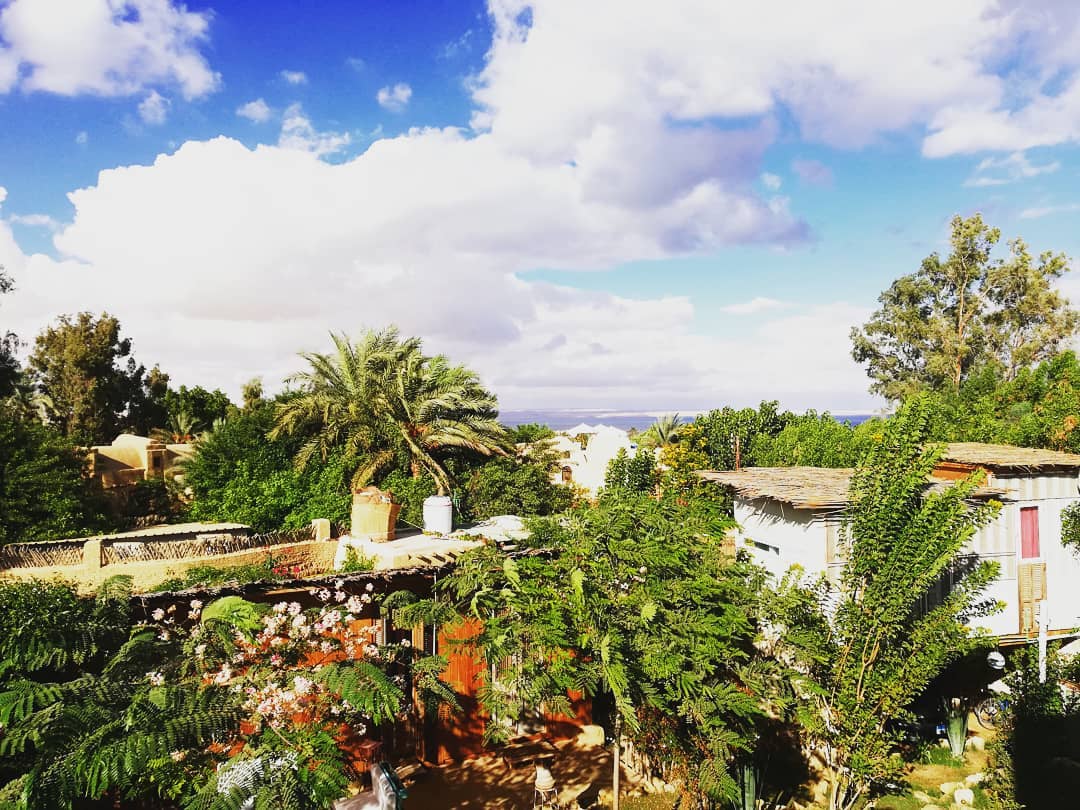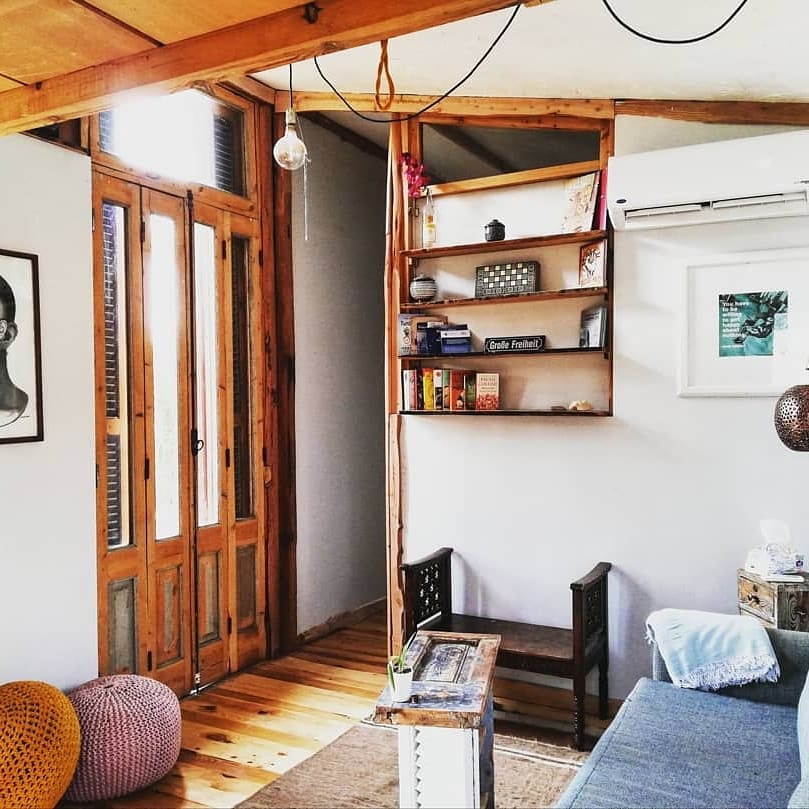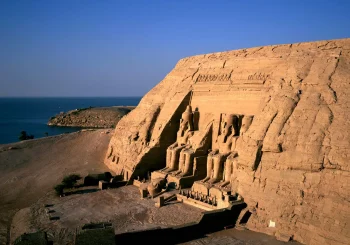
Following a wooden sign that reads ‘Barefoot in Tunis’ down a narrow dirt road in the small, but ever so charming, Tunis Village in Fayoum, one will find a sustainable haven nestled away at the end of it.
When visiting the famed pottery village of Tunis in Fayoum, one will find a number of wonderful accommodation options, from hotel-like lodges to various Airbnb listings; Barefoot in Tunis however, is not a mere Airbnb listing, but an experience in and of itself.
“When I first came [to Tunis Village] ten years ago, I fell in love with the serenity of this small village. I loved the fact that expats and local fellaheen live door to door. Over the years, I came back several times and always enjoyed its calm and nature,” explains Sahra Gemeinder, owner of Barefoot in Tunis, as to why she decided to build Barefoot in Tunis in the first place.

Barefoot in Tunis is a small area of land which hosts a selection of three tiny houses that guests may rent for short or long periods of time, each of which was built using sustainable methods and recycled materials. The tiny house culture or movement has actually been steadily on the rise in recent years.
More and more people all over the world have opted to ‘live with less’ by living in tiny homes that are built sustainably and have just the right amount of things needed in attempts to promote general sustainable living. This ‘tiny house culture’ is all about getting rid of excess materials we may not necessarily need and limiting the use of various resources such as electricity and water.
“I was working in the field of sustainable tourism promotion for a few years and found the topic super interesting,” Gemeinder tells Egyptian Streets, “Egypt has great potential to become a major player in the sustainable tourism fields as it is endowed with a range of natural resources; but they are not utilized properly.”

With that in mind, Gemeinder set out to buy a piece of land through which she would be able to promote sustainable tourism in Egypt. Tunis Village seemed like a perfect option to do just that for several reasons, she explains, among which include the fact that it is a mere two hour drive away from Cairo – making it both an easy weekend getaway, as well as facilitating the running of errands for her personally.
Gemeinder goes on to say that, “People are very friendly and its nature is impeccable; you have fresh air, no traffic, can go to the desert, sit at the lake, walk through green fields, be creative and do pottery, or lie at the pool. All this in one location – what else does one need?”
When it comes to how she settled on creating a range of tiny homes available to rent in one place, Gemeinder explains that she researched a lot into sustainable construction methods and tiny homes kept popping up.

“Those utterly efficient houses looked gorgeous and were placed in nature so your garden becomes your living room,” she says “Being a child of nowadays consumerist culture myself, I found the idea to minimize and learn to live with less quite intriguing; more so, the idea of building a house myself was quite exciting.”
Gemeinder also goes on to say that one of her goals out of these tiny homes was to be able to show people that environmental conscious construction and focusing on the essentials of living can still be luxurious. “Many fly to other countries to stay in nature retreats and enjoy that its beauty lies in its simplicity. Why shouldn’t we be able to do so in our own country? You don’t need much space to create a little refugee,” she says.
The actual construction of these houses, however, was quite the learning process. “The first [house] (Barefoot – which accommodates three people) was the hardest to build; I had no experience whatsoever and made a lot of mistakes. It took a while until I understood what I want and until I found a team of good people that understood what I want and how I want it done,” Gemeinder says, “Tea Cup (which accommodates two people) was easier… For days and weeks, we collected and filled sand bottles whenever there was some time left. In the end, we managed to build two walls with sand filled bottles, and they looked beautiful; their insulation is fantastic and they are super easy to build with.” After the experience of the two previous tiny homes, the final tiny home built – El Sheesh, which accommodates up to four people – was ultimately easier to build.

“A tiny house is much kinder to the environment than a commercial house,” Gemeinder explains to Egyptian Streets, “Because the houses are so small (27, 16 and eight sqm), I could use natural materials like wood for the construction instead of cement, which makes its footprint per se lighter, especially since most of it is up-cycled.”
She goes on to say that, “Its small size also allows you to insulate the whole house. Barefoot, for example, is insulated from the walls to the roof. Due to the good insulation and the small size a small AC is enough to heat and cool all parts of the house, and this helps to keep electricity costs low and the environmental footprint even smaller.”
By using various materials such as the old support beams of an Egyptian villa, old window shutters and sand-filled bottles, all of Gemeinder’s tiny homes are 50-70 percent up-cycled. In addition to this, all of the houses also have at least one outlet where grey water gets channeled in the garden, trying hard to re-use water as best as possible.

In a sense, Barefoot in Tunis offers the charming quality of being surrounded by nature all around – not just through the gorgeous evergreen garden space that one delightedly wakes up to in the morning, but through the materials of the homes themselves.
Barefoot in Tunis truly is a warm and inviting experience that will have anyone visiting revel in the beauty and calmness of Egypt’s wonderful nature, all while inspiring an intrigue in the many wonders of sustainable living.
When it comes to what the future has in store for Gemeinder and her tiny homes, she simply says, “I am always striving to make Barefoot in Tunis better and more environmentally conscious. Let’s see what 2021 will bring, I am curious myself.”
*Check out Barefoot in Tunis’ Instagram page here.
*Featured image courtesy of Barefoot in Tunis Facebook page.






Comment (1)
[…] Learn more […]